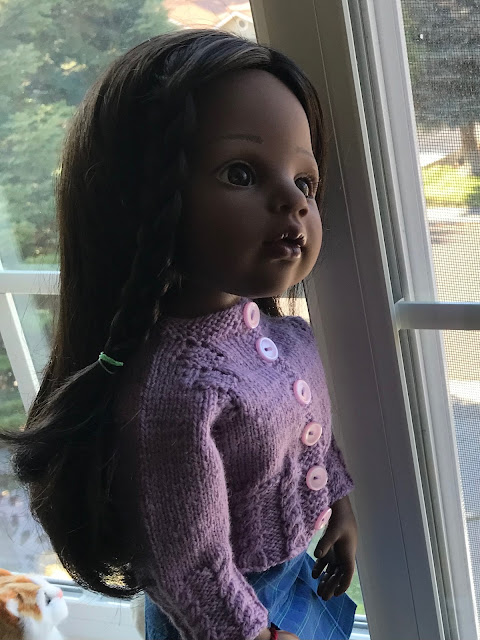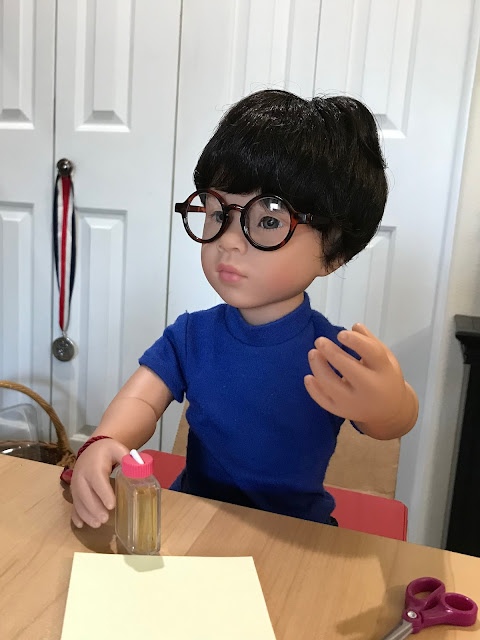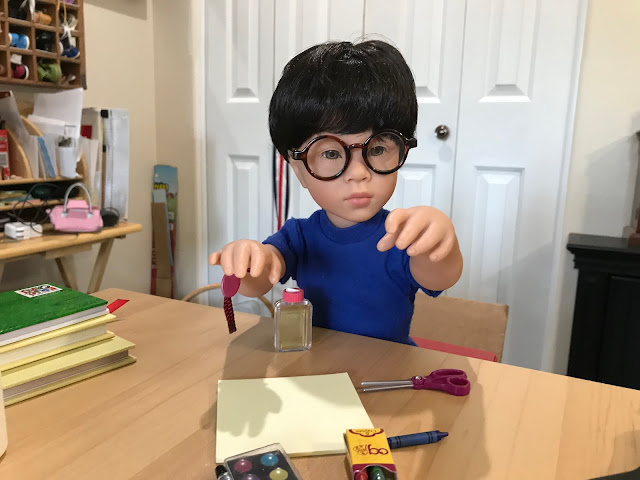Charlotte and Mariah had been standing in the window of the workroom, watching for the boys to come home, when they saw one of the neighborhood dogs chase a cat across the yard in front of the house across the street.
The cat reached a tall fence and turned around. The girls saw one paw come out, and then the dog jumped back. The dog turned and ran away, while the cat climbed the fence and escaped in another direction.
"Real cats and dogs don't seem to get along very well," Charlotte said.
"I've noticed that," Mariah said. "I wonder why that is."
"There they are," Charlotte exclaimed. Mariah turned and saw the boys coming around the corner. They had gone to the woods to play while it was still light outside. Soon the boys would be coming up to the workroom.
The four dolls had planned to do their homework together at the big table in the workroom. They often did their homework together, because sometimes there was something one of them didn't understand, and they could ask the other dolls about it. Talking with others about something they were learning sometimes made it easier to understand and remember.
In a few minutes the boys were making their way up the stairs.
As they all settled finally around the big table, where they would be doing their homework, Mariah and Charlotte began to tell the boys about the dog they had seen chasing the cat. "We've been wondering," Mariah said, "why dogs and cats don't get along."
Emil knows animals pretty well, because he can hear them when they talk to each other in their heads. It's a special gift that only he has. He had learned that he had developed this special gift because he had spent so much time unable to hear before he got his special glasses.
Mandy had done what she called research (REE-serch) on the internet. She had started with what she knew and looked up all the ideas she had about Emil's gift might and had learned a lot about it. She checked out what she read, to see if it was true. She had explained to Emil and the other dolls that probably happened was that the part of his doll brain that was supposed to be used for sounds had nothing to do for the first few months after he left the doll factory, so it learned how to hear animals.
After he got his special glasses, Emil could hear sounds, but he's still able to hear and understand what animals are saying. Not just toy animals, either. He can hear real animals, like squirrels and birds. He also can hear real dogs and cats.
"Real dogs and cats can get along well," he said, "if they live in the same family."
"If they grow up together," he pointed out, "usually become good friends, or at least, they aren't enemies or afraid of each other. They learn to trust each other."
"It's easier," he said, "if one of them is still very young when they meet. A grownup dog will learn to get along with a kitten. It can work the same way for an older cat and a puppy. The family introduces them to each other carefully at first."
"I think," Emil went on, "it's because the young animal of one kind hasn't had bad experiences with the other kind yet, and babies aren't scary to older animals. It's much harder with an older cat and an older dog, though. It takes longer for them to trust each other."
"I wonder why that is," Billy said. "When two grownup dogs meet for the first time, they seem to get along OK, unless one of them has something the other one wants.
The other dolls had been wondering the same thing.
"I think it's something called body language," Emil said.
The other dolls just looked at him.
He knew that was doll body language for they wanted him to explain.
"Well," Emil began, "when dogs and cats talk to each other they use their bodies to help them with it, but how dogs use their bodies, and how cats do it is different. It can mean something just the opposite."
"For instance," he said, "usually if a dog wags their tail, it means they're friendly. That is, if they aren't barking at someone or showing their teeth in a mean way. Dogs can't keep their tails from moving sometimes, but if they aren't barking at you or making an angry face, it means they're friendly." (Emil had learned all this from the neighborhood dogs.)
"You still should be careful, though, if it's a dog you don't know," Emil explained. "Ask the owner first if it's OK, then let the dog sniff the back of your hand. Make a fist if you can bend your fingers."
The other dolls nodded. Billy said, "I knew that." They all did.
"With cats, though," Emil went on, "a wagging tail can mean they are angry, or that they are ready to attack, even if it's just in play."
The three dolls thought about that. "I think I've seen cats do that," Charlotte said.
"Another example," Emil went on, "is when they have their ears back, flat on their heads. When a dog does that without showing their teeth, they're saying they're sorry; don't be mad. Or maybe they're afraid."
"If a cat does that, you'd better watch out!" Emil pointed out. "They don't like what happened, and they may be ready to use their sharp claws."
Again, the other three dolls thought about it.
"Or," Emil continued, "a dog might roll over on their back and show you their tummy. They're trying to let you know that you're the boss. It's like saying 'don't hurt me.'"
"Cats might roll over on their backs" he explained, "when they fight, because they can fight with all four feet that way. They could be playing, because a lot of play is practicing things they do to protect themselves, but be careful until you know if they're just playing."
"Like dogs do something called a play bow," Emil said. "It means they want to play with you."
"Cats do that," he concluded, "if they're ready to pounce on something, like a mouse, but they often move back and forth on their back feet while they're doing it. Still, it might look the same to a dog. I could give you lots more examples, but you see," Emil pointed out, "it's really easy for dogs and cats to misunderstand each other."
Billy, Charlotte and Mariah all could see how this might be confusing until you understood it.
"The reason," Emil explained, "I think cats and dogs who live together get along is because they learn each other's body language, like dolls who learn each other's language or habits. They don't misunderstand each other so much anymore, so they trust each other."
"Real dogs and cats are just like us!" Pierre said to Freckles and Marmalade, as the dolls began working on their homework.
Freckles responded with a play bow, and the two dogs started to play, which meant they were pretending to attack each other and fight. Marmalade just watched.
Pretending to fight is fun, Marmalade thought to himself, but it's more fun if you don't invite them. I'll just wait until they've forgotten all about me and let it be a surprise.
Mandy: Götz Happy Kidz Katie 2015
Charlotte: Götz Happy Kidz Anna in Paris
Mariah: Götz Happy Kidz Mariah, "Chosen" from My Doll Best Friend
Billy: Götz Happy Kidz Lily at London
Emil: Götz Happy Kidz Emilia
"The Doll's Storybook" is not affiliated with Gotz Dolls USA Inc. or Götz Puppenmanufaktur International GmbH.
Watch for the next story each Friday afternoon at 1:00 PM Pacific Time.
<a href="https://www.bloglovin.com/blog/19832501/?claim=j3fj3mbb8kt">Follow my blog with Bloglovin</a>
Copyright © 2022 by Peggy Stuart







































No comments:
Post a Comment